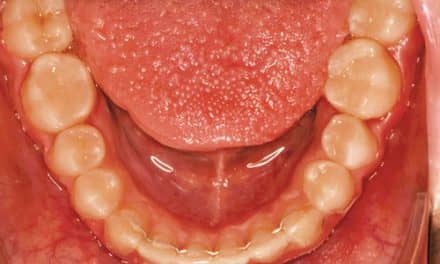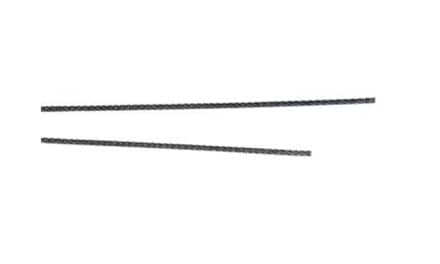by Nona Naghavi, DDS, and Laurance Jerrold, DDS, JD
How to approach the final phase of treatment
It has been said that the only orthodontists who don’t experience relapse are those who don’t follow up with their patients years after treatment has ended.1 The bad news is that relapse goes hand in hand with the practice of orthodontics. The good news, however, is that following patients in retention actually makes you a better diagnostician as well as a better mechanotherapist. Retention should be thought of as a phase of treatment; it is not an afterthought. Post-treatment retention and final stability of the finished case are intertwined and inseparable from the preceding phases of therapy.2
The Retention Hierarchy

The goal of retention is to provide the patient with the most appropriate retention modality that will yield optimal stability of the finished result and require the least amount of maintenance. Retention incorporates a spectrum of interventions, ranging from observation to permanent fixed retention. The hierarchy of retentive modalities, from least intrusive to most intrusive, is the following:
- observation (a correction of a single-tooth anterior crossbite is self-retentive, for example);
- habit therapy (such as myofunctional therapy);
- removable appliances;
- occlusal equilibration;
- reproximation/air rotor stripping (including keystoning);
- adjunctive mucogingival surgery (supercrestal circumferential fiberotomy and frenectomy); and
- fixed appliances (supra- and intracoronal).
Retention History
According to Angle,3 the main principle of retention is to prevent the teeth from moving in the direction from which they came. However, Vaden4 notes that little is known about treatment changes that occur after a decade or so post-treatment; and according to Little,5 no clinical findings seem to conclusively predict relapse in a given case.
Brodie6 noted that the stability of teeth is at the mercy of other highly dynamic factors such as the muscular influences of the tongue, lips, and cheeks, and their effect on the archform; the form, number, and arrangement of the roots; the structure of the bone; and the relationship of the jaws to the cranium and the rest of the body via their attachments such as the physiology of the muscles of mastication, the TMJ, and the hyoid complex. He postulated that each of these factors supplies a tangible force, either static (tooth form) or dynamic (muscle tension). He concluded that it was just as important to restore normalcy to the musculature balance as it was to treat the malocclusion, and that retention must be designed with this in mind. In addition, just before placing a retainer, he debonded the patient and allowed for settling. This would help him plan the right retainer by observing what needed retention and what didn’t. He also followed a “reduction process” whereby he gradually cut off pieces of the retainers, removing support in the order of the tendencies to stabilize.
Physiologically, after orthodontic treatment is completed, reorganization of the periodontal ligament occurs over a 3- to 4-month period. Reorganization of the collagenous fiber network, however, typically occurs over a 4- to 6-month period, while supercrestal elastic fibers remain deviated for up to a year. Both of these fiber networks apply forces that cause relapse.7 Melrose8 found that after tooth movement, residual forces remain in the periodontal tissues surrounding the teeth that have recently moved, which is why Proffit9 states that every patient needs retainers for at least a few months.
This is in contrast to Boese’s10 findings. Boese applied fiberotomy and reproximation to a set of subjects, none of whom had lower arch retention of any sort. His reasoning was that lower retainers postponed the natural arch-length loss. His decision not to use lower retention allowed for physiologic and gradual loss of arch length to occur and to be dealt with as it occurred. His approach of “serial reproximation” started early in treatment and continued at least
6 months after complete debonding. He argued that “favorably shaped” lower incisors resist relapse and that a better understanding of the biology of the lower anterior sextant—and not the orthodontic mechanics involved—can ensure greater stability.
This thought was refuted by Scarff,11 who stated that the removal of tooth material, either by extraction or ARS before, during, and after orthodontic treatment, is in no way equal to the lifelong physiologic attrition seen and studied in the Australian Aboriginals. He also advocated leaving the distal angle of lower lateral incisors 0.05 mm labial to the canines, since this creates a safety mechanism against lower-incisor irregularity as the inter-canine width decreases during aging. Peck and Peck12 also noted that lower incisors show more stability when their mesiodistal dimension is smaller than their buccolingual dimension, and that this finding holds true even in the absence of a Bolton discrepancy.
Relapse Factors

All removable retainers should be worn 24/7 for the first month.
The problem of relapse is a multifactorial issue. As with Shiva, the Indian God, many hands are at work. On one hand is civilized man’s nonattritional dentition. On another, we find the hereditary process of physiologic, lifelong, continual eruption and mesial migration of teeth. The next hand holds the abnormality of lip posture, tongue, and other orofacial muscles that produce internal and external pressures that affect tooth position. Another hand dictates that whatever remaining growth the patient has will influence the postretention position of the teeth.13 Still another hand holds the repercussions associated with the failure to place teeth over their respective denture bases. The next hand contains the bioelastic characteristics of the PDL and other gingival fibers affecting tooth stability. Another hand involves the inclined planes of the teeth and the interarch cusp/fossa relationship. Finally, the last hand holds the cooperation of the patient in complying with the retention protocol.14 These same factors also cause dental instability in patients who never underwent orthodontic treatment. Teeth are in a constant state of dynamic equilibrium, resulting in positional change over time. However, this natural physiologic movement should not be confused with orthodontic relapse or rebound.
Pepicelli et al15 studied mandibular muscles and their importance in orthodontic retention, particularly as the musculature relates to a patient’s facial type. They postulated that brachyfacial individuals can tolerate more protrusion, proclination, and expansion than dolichofacial individuals. Many have attempted to use the musculature during the finishing and retentive phases of treatment. Tweed believed that some cases needed no retention whatsoever, so he debonded his cases from lateral incisor to the terminal molars and allowed 2 to 4 weeks of function, which he believed would dictate the normal cuspid and dental arch breadth.16 Alexander1 also allowed for posterior settling for 6 weeks prior to complete debond. He advocated sectioning the mandibular wire distal to canines and the maxillary wire distal to laterals to allow for settling of upper cuspids. He also advocated the use of intermaxillary posterior elastics in one arch with a stabilizing archwire in the opposing arch to allow for specific posterior settling.
Many practitioners believe that holding the teeth for several months in the finishing archwire is the first step in the retention phase of treatment. Begg2 called this approach flawed because he believed that teeth should not be held rigidly after completion of treatment because this has the potential to deny the underlying bone the stimulation that stems from the forces of mastication. If bone is not stimulated in this fashion, it may not acquire its physiologic ability to withstand occlusal forces. This can result into teeth moving into wrong positions once the appliances came off. Since he advocated the use of lighter and more resilient wires for treatment as opposed to heavy, rectangular finishing arches, his thinking was that bone deposition readily takes place alongside bone resorption throughout treatment, causing the roots of the teeth to become more firm in their sockets. Proffit9 agreed with this notion, stating that holding the teeth with passive archwires cannot be considered the beginning of retention.
Much emphasis has been put on the state of the occlusion at the end of orthodontic treatment and how it affects retention. Many believe that if malocclusions are diagnosed and treated ideally, the forces from the inclined planes of the cusps as well as the cusp/fossa interdigitation will be sufficient to balance the denture and hold the occlusion in place, thus eliminating the need for retainers.8 Lewis17 disagreed, arguing that osteoid-type bone cannot hold teeth in their proper place as well as mature bone can because, in order to withstand the stresses and forces of both mastication and muscle pull, a period of retainer use is necessary until mature bone is reorganized. Roberts18 noted that Roth believed in overcorrection with his built-in appliance prescription to ensure arriving at Andrew’s six keys of occlusion after physiologic rebound had taken place, and that this approach was a prevention against relapse. While optimal occlusion may or may not provide sufficient retention capabilities, gnathological positioners19 as well as the presence of wisdom teeth20 have been shown to have little effect.
Retention Recommendations

A good rule of thumb is to follow the patient in retention for as long as the treatment took.
How long one should retain the finished occlusion is a commonly asked question. There are two good rules of thumb. First, as recommended by Hahn,21 retain the case for at least as long as the treatment took. If treatment took 3 years, monitor for 3 more years; if it took only a year to correct, hold the result for 1 year. Putting this in clinical perspective, find the mode of retention that is least invasive but gives you the most desired result with the retainer being worn the least amount of time.
The patient must be titrated down to the least amount of time necessary, and since patients can’t monitor the titration, the practitioner must do so. Melrose et al8 talked about a monitoring schedule. A good example might be that retainers are started 24/7 and the patient returns in 4 weeks to check for fit, irritation, and allergic response. The second visit is 2 months later. Assuming the finished result is still stable, retention wear can be decreased to every night and every other day. After 3 more months, if the desired result is still stable, decrease retainer wear to nights only. If the results are still stable 6 months later, instruct the patient to wear retainers every other night. In 6 more months, if the results are still as desired, the patient can be titrated off the appliance entirely. If, at any time, the patient says that the retainer is tight, or the teeth are starting to move, you have discovered the least amount of time necessary for retainer wear to maintain the desired result. It is an art—a dance, if you will, that requires two people: the orthodontist and the patient.

Retention should be considered to be “straight-tooth insurance.”
Orthodontic cases should not be started unless an adequate retention plan has been decided upon.21-23 While this makes good clinical sense, the actual retainer to be employed uses the initial assumption, tempered by the finished clinical result and the expected cooperation of the patient. As there is no difference between fixed and removable retention wear,24 if removable retainers are used, design is the next issue.
Clinicians should always ask themselves, “What is it I am trying to retain?” If a case started out with anterior crowding and was treated nonextraction, during the retentive phase of treatment, the teeth are not going to flare, procline, or splay. The labial bow then becomes superfluous unless it is required for added retention. Conversely, if the archforms were expanded, the only direction that relapse will occur in is to constrict,13,16 so only lingual support is needed. If the patient is allergic to acrylic or if there was a habit and the practitioner wants the palate free for proprioception, a Hawley-type frame can be constructed without palatal coverage.25 If the case is finished before complete eruption of the second molars, be sure that your clasping design does not inhibit eruption of these teeth. Once again, it becomes obvious that retention, even in the design of the appliance, is not “one-size-fits-all.”
In summary, the following considerations26 can be used as a checklist:
- Teeth that have been moved orthodontically have a tendency to return to their former position.
- Elimination of the cause of malocclusion may prevent relapse.
- Malocclusions should be slightly overcorrected as a safety measure.
- Proper occlusion, cusp/fossa relationships, and incline plane action are potent factors in holding teeth in their corrected positions.
- Bone and adjacent tissues must be allowed to reorganize around newly positioned teeth.
- Placing the lower incisors upright over basal bone has a tendency to enhance good alignment.
- Corrections carried out during periods of growth have less likelihood toward relapse.
- The amount and direction that teeth have been moved has an effect on the likelihood of relapse.
- Archform, particularly in the mandibular arch, cannot be permanently altered by appliance therapy.
Regardless of who follows the patient, the patient has to look upon the retention protocol as “straight-tooth insurance.” If they pay the premium by complying with their retention responsibilities, they get the protection of the stability of the results. If they stop paying the premium, they lose the protection.
Nona Naghavi, DDS, is a second-year resident at Jacksonville University School of Orthodontics. She can be reached at
Laurance Jerrold, DDS, JD, is president of Orthodontic Consulting Group LLC. He can be reached at
References
- Alexander RG. The Alexander Discipline: contemporary concepts and philosophies. Orange, Calif: Ormco Corp; 1986:431.
- Begg PR, Kesling PC. Begg Orthodontic theory and technique. 3rd ed. Philadelphia: W.B. Saunders Co; 1977:646.
- Angle EH. The Angle System of Regulation and Retention of the Teeth, and Treatment of Fractures of the Maxillae. 5th ed. Philadelphia: White Dental Manufacturing Co; 1899.
- Vaden JL, Harris EF, Gardner RL. Relapse revisited. Am J Orthod Dentofacial Orthop. 1997;111(5):543-553.
- Little RM. Stability and relapse of dental arch alignment. Br J Orthod. 1990;17(3):235–241.
- Brodie AG. Retention. Angle Orthod. 1939;9(2):3-17.
- Reitan K. Tissue rearrangement during retention of orthodontically rotated teeth. Angle Orthod. 1959; 29:105-113.
- Melrose C, Millett DT. Toward a perspective on orthodontic retention? Am J Orthod Dentofacial Orthop. 1998; 113(5):507-514.
- Proffit WR, Fields Jr, HW, Sarver DM. Contemporary Orthodontics. 4th ed. St. Louis: Mosby; 2007:219.
- Boese LR. Fiberotomy and reproximation without lower retention 9 years in retrospect: Part II. Presented at the biennial meeting of the Angle Society. Hilton Head. South Carolina. October, 1979.
- Scarff AW. The retention phase of treatment. Retention: the never ending saga? Aust Orthod J. 1993; 211-213.
- Peck H, Peck S. A concept of facial esthetics. Esthetics. 1970; 40(4):284-318.
- De La Cruz A, Sampson P, Little RM, Artun J, Shapiro PA. Long-term changes in arch form after orthodontic treatment and retention. Am J Orthod Dentofacial Orthop. 1995;107(5):518–530.
- Kaswiner B. Retention-A most important phase of orthodontic treatment. Int J Orthod. 1970;8(4):148-153.
- Pepicelli A, Woods M, Briggs C. The mandibular muscles and their importance in orthodontics: a contemporary review. Am J Orthod Dentofacial Orthop. 2005;128:774-780.
- Tweed CH. Clinical Orthodontics. Volume 2. St. Louis: C.V. Mosby Co; 1966:928.
- Lewis PD. The labiobuccal retainer. Presented at the Biennial Meeting of the Edward H. Angle Society of Orthodontia, Washington, DC, October, 1957.
- Roberts G. The retention phase of treatment. Retention-still the stepchild. Aust Orthod J. October 1993;29-31.
- Durbin DS, Sadowsky C. Changes in tooth contacts following orthodontic treatment. Am J Orthod Dentofacial Orthop. 1986;90:375-382.
- Blake M, Bibby K. Retention and stability: a review of the literature. Am J Orthod Dentofacial Orthop. 1998;114(3):299-306.
- Hahn GW. Retention: the stepchild of orthodontia. Read before the Northern Section of the Pacific Coast Society of Orthodontists, Victoria, BC, June 1943.
- Riedel RA. A review of the retention problem. Presented before the Edward H Angle Society, Colorado Springs, October, 1959.
- Kaplan H. The logic of modern retention procedures. Am J Orthod Dentofacial Orthop. 1988;93(4):325-340.
- Atack N, Harradine N, Sandy JR, Ireland AJ. Which way forward? Fixed or removable retainers. Angle Orthod. 2007;77(6):954-959.
- Jerrold L. A toothborne Hawley type retainer. J Clin Orthod. 1984;18(4):282-283.
- Graber TM, Vanarsdall RL. Orthodontics: Current Principles and Techniques. St. Louis: Mosby; 2002;34:1012.





